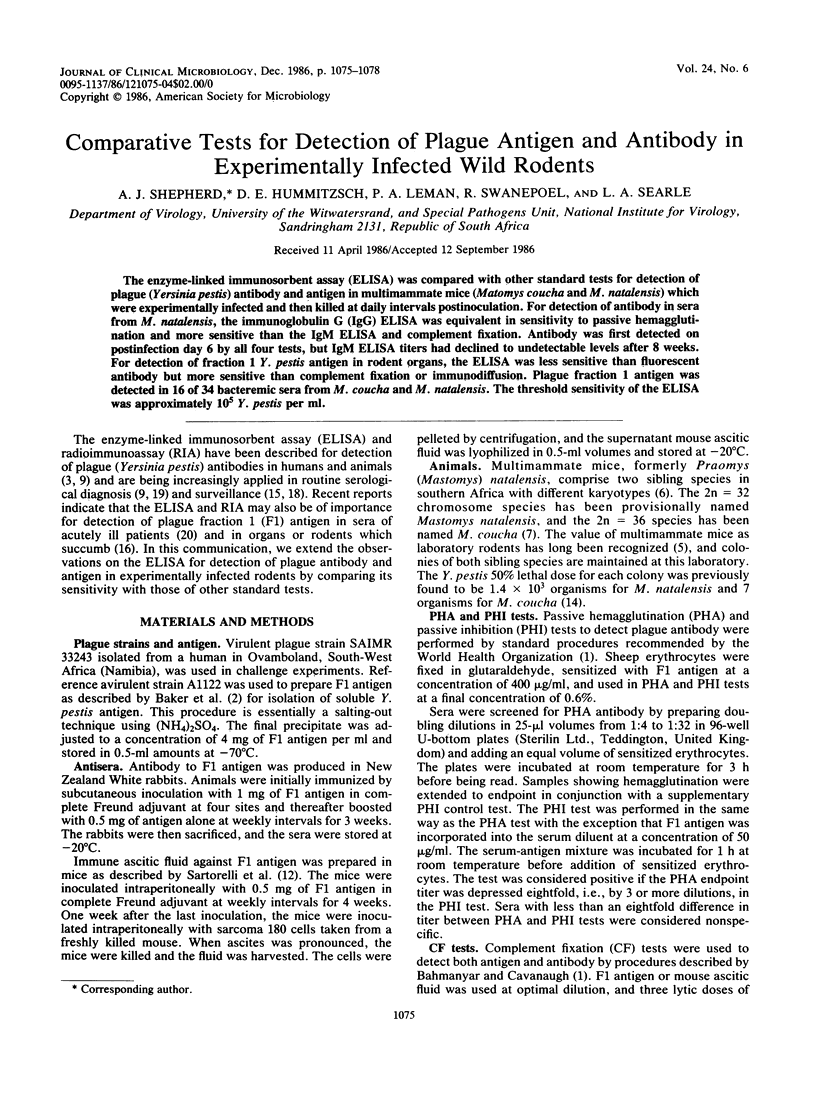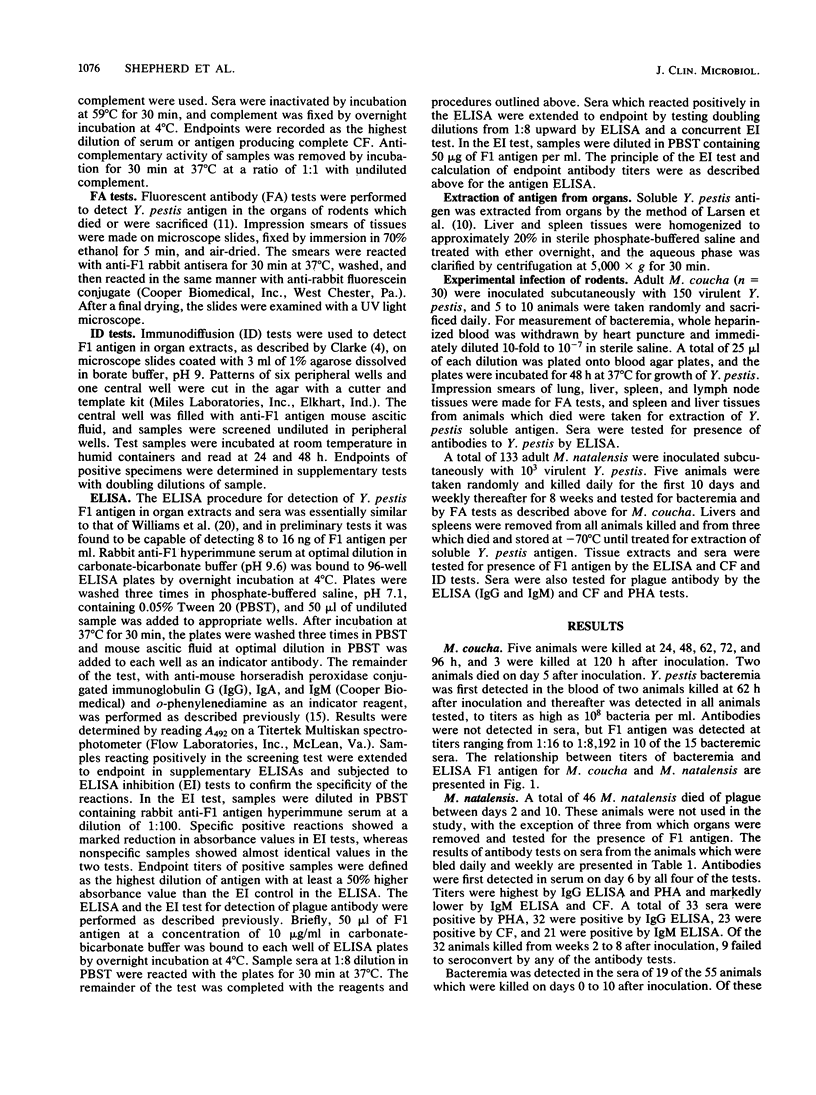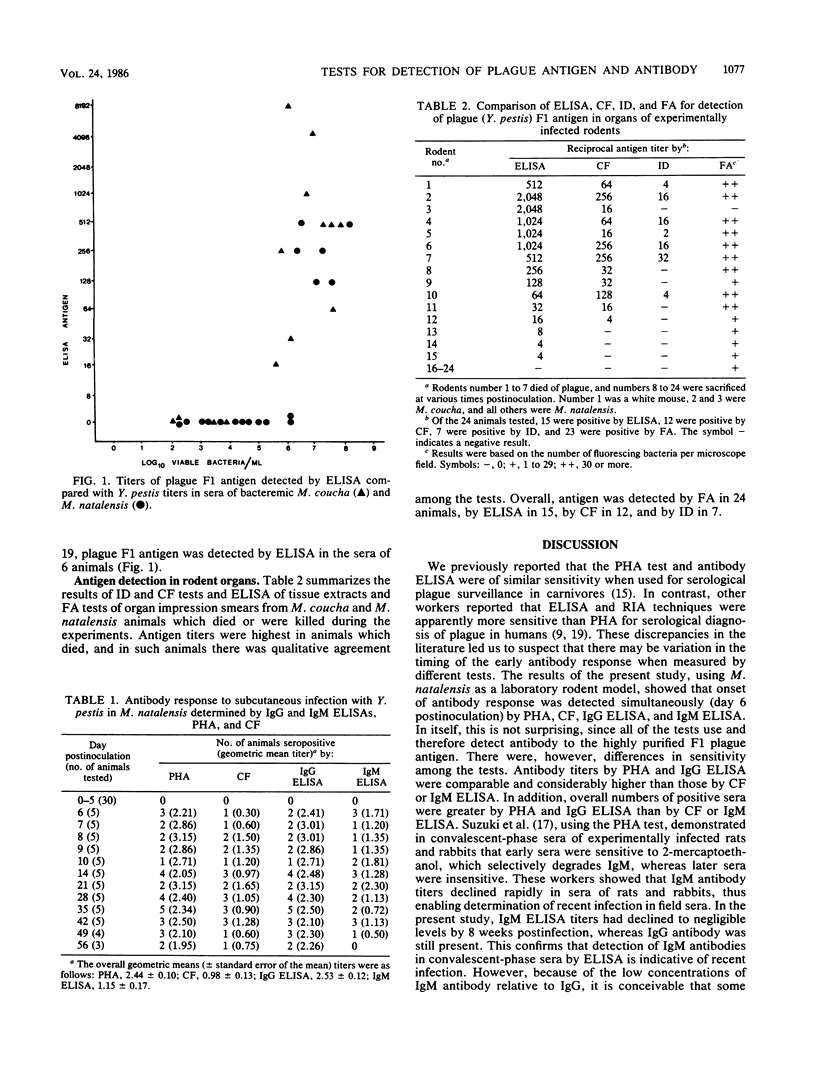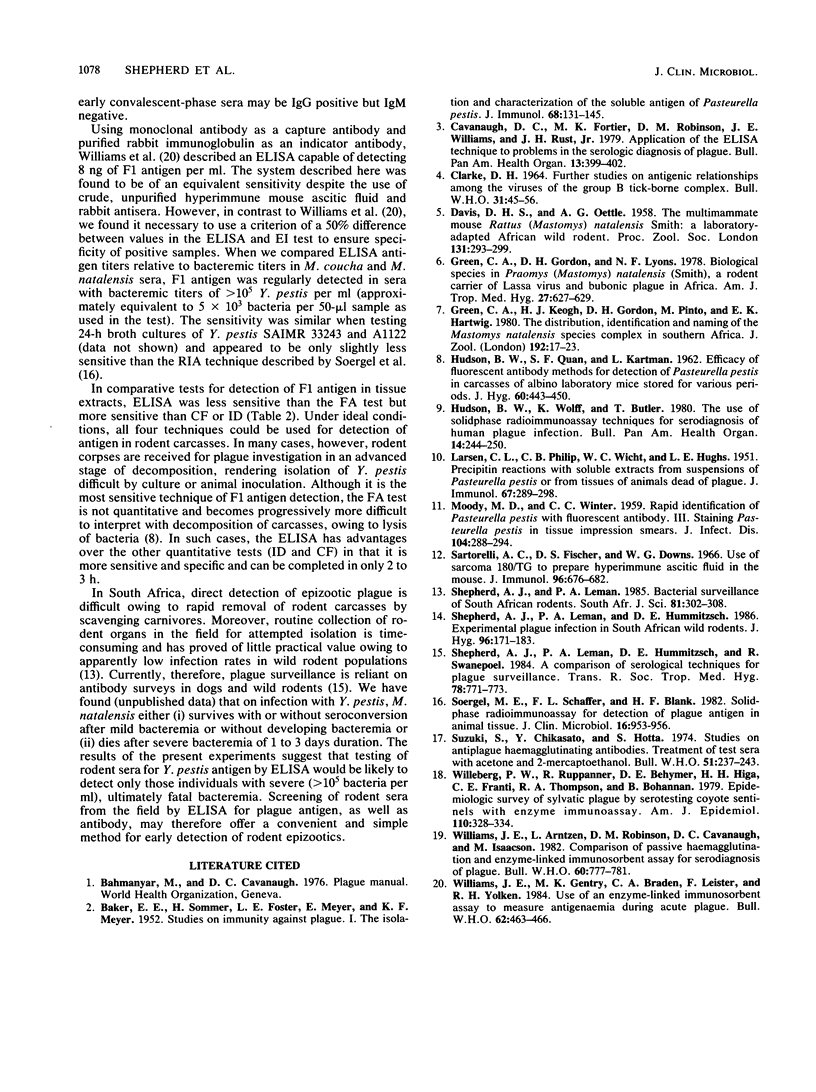Abstract
The enzyme-linked immunosorbent assay (ELISA) was compared with other standard tests for detection of plague (Yersinia pestis) antibody and antigen in multimammate mice (Mastomys coucha and M. natalensis) which were experimentally infected and then killed at daily intervals postinoculation. For detection of antibody in sera from M. natalensis, the immunoglobulin G (IgG) ELISA was equivalent in sensitivity to passive hemagglutination and more sensitive than the IgM ELISA and complement fixation. Antibody was first detected on postinfection day 6 by all four tests, but IgM ELISA titers had declined to undetectable levels after 8 weeks. For detection of fraction 1 Y. pestis antigen in rodent organs, the ELISA was less sensitive than fluorescent antibody but more sensitive than complement fixation or immunodiffusion. Plague fraction 1 antigen was detected in 16 of 34 bacteremic sera from M. coucha and M. natalensis. The threshold sensitivity of the ELISA was approximately 10(5) Y. pestis per ml.
Full text
PDF



Selected References
These references are in PubMed. This may not be the complete list of references from this article.
- BAKER E. E., SOMMER H., FOSTER L. E., MEYER E., MEYER K. F. Studies on immunization against plague. I. The isolation and characterization of the soluble antigen of Pasteurella pestis. J Immunol. 1952 Feb;68(2):131–145. [PubMed] [Google Scholar]
- CLARKE D. H. FURTHER STUDIES ON ANTIGENIC RELATIONSHIPS AMONG THE VIRUSES OF THE GROUP B TICK-BORNE COMPLEX. Bull World Health Organ. 1964;31:45–56. [PMC free article] [PubMed] [Google Scholar]
- Cavanaugh D. C., Fortier M. K., Robinson D. M., Williams J. E., Rust J. H., Jr Application of the ELISA technique to problems in the serologic diagnosis of plague. Bull Pan Am Health Organ. 1979;13(4):399–402. [PubMed] [Google Scholar]
- Green C. A., Gordon D. H., Lyons N. F. Biological species in Praomys (Mastomys) natalensis (Smith), a rodent carrier of Lassa virus and bubonic plague in Africa. Am J Trop Med Hyg. 1978 May;27(3):627–629. doi: 10.4269/ajtmh.1978.27.627. [DOI] [PubMed] [Google Scholar]
- HUDSON B. W., QUAN S. F., KARTMAN L. Efficacy of fluorescent antibody methods for detection of Pasteurella pestis in carcasses of albino laboratory mice stored for various periods. J Hyg (Lond) 1962 Dec;60:443–450. doi: 10.1017/s002217240002057x. [DOI] [PMC free article] [PubMed] [Google Scholar]
- Hudson B. W., Wolff K., Butler T. The use of solid-phase radioimmunoassay techniques for serodiagnosis of human plague infection. Bull Pan Am Health Organ. 1980;14(3):244–250. [PubMed] [Google Scholar]
- LARSON C. L., PHILIP C. B., WICHT W. C., HUGHES L. E. Precipitin reactions with soluble antigens from suspensions of Pasteurella pestis or from tissues of animals dead of plague. J Immunol. 1951 Oct;67(4):289–298. [PubMed] [Google Scholar]
- MOODY M. D., WINTER C. C. Rapid identification of Pasteurella pestis with fluorescent antibody. III. Staining Pasteurella pestis in tissue impression smears. J Infect Dis. 1959 May-Jun;104(3):288–294. doi: 10.1093/infdis/104.3.288. [DOI] [PubMed] [Google Scholar]
- Sartorelli A. C., Fischer D. S., Downs W. G. Use of sarcoma 180/TG to prepare hyperimmune ascitic fluid in the mouse. J Immunol. 1966 Apr;96(4):676–682. [PubMed] [Google Scholar]
- Shepherd A. J., Leman P. A., Hummitzsch D. E. Experimental plague infection in South African wild rodents. J Hyg (Lond) 1986 Apr;96(2):171–183. doi: 10.1017/s0022172400065943. [DOI] [PMC free article] [PubMed] [Google Scholar]
- Shepherd A. J., Leman P. A., Hummitzsch D. E., Swanepoel R. A comparison of serological techniques for plague surveillance. Trans R Soc Trop Med Hyg. 1984;78(6):771–773. doi: 10.1016/0035-9203(84)90014-2. [DOI] [PubMed] [Google Scholar]
- Soergel M. E., Schaffer F. L., Blank H. F. Solid-phase radioimmunoassay for detection of plague antigen in animal tissue. J Clin Microbiol. 1982 Nov;16(5):953–956. doi: 10.1128/jcm.16.5.953-956.1982. [DOI] [PMC free article] [PubMed] [Google Scholar]
- Suzuki S., Chikasato Y., Hotta S. Studies on antiplague haemagglutinating antibodies. Treatment of test sera with acetone and 2-mercaptoethanol. Bull World Health Organ. 1974;51(3):237–243. [PMC free article] [PubMed] [Google Scholar]
- Willeberg P. W., Ruppanner R., Behymer D. E., Higa H. H., Franti C. E., Thompson R. A., Bohannan B. Epidemiologic survey of sylvatic plague by serotesting coyote sentinels with enzyme immunoassay. Am J Epidemiol. 1979 Sep;110(3):328–334. doi: 10.1093/oxfordjournals.aje.a112818. [DOI] [PubMed] [Google Scholar]
- Williams J. E., Arntzen L., Robinson D. M., Cavanaugh D. C., Isaäcson M. Comparison of passive haemagglutination and enzyme-linked immunosorbent assay for serodiagnosis of plague. Bull World Health Organ. 1982;60(5):777–781. [PMC free article] [PubMed] [Google Scholar]
- Williams J. E., Gentry M. K., Braden C. A., Leister F., Yolken R. H. Use of an enzyme-linked immunosorbent assay to measure antigenaemia during acute plague. Bull World Health Organ. 1984;62(3):463–466. [PMC free article] [PubMed] [Google Scholar]


